Are you tired of rats and mice invading your bird feeder and scaring away the birds? Having these unwanted visitors cause the beautiful birds to stop visiting your yard can be frustrating. This disappointment is especially felt by bird enthusiasts who enjoy birdwatching.
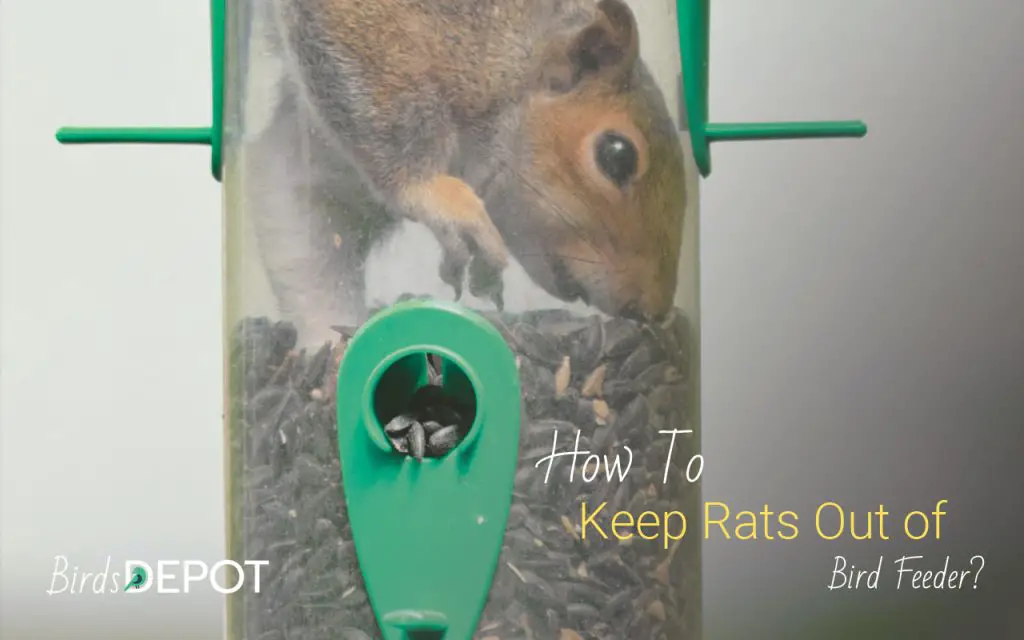
Don’t worry, there are several effective methods to keep rats and mice away from your bird feeder. Let us help you regain control of your feeder and prevent rat problems. We’ve covered you, from using owl decoys to securing feeders inside baffles or on poles.
Understanding Rat Behavior Traits for Successful Elimination
Preventing rat infestation in your yard is crucial. Rats are not only unsightly and unwelcome guests, but they also pose serious health risks. They carry diseases that can harm both humans and birds. Moreover, if they find easy access to food in your bird feeder, they will keep coming back. Here are the important factors you should know:
Why rats are attracted to bird feeders
Bird feeders can attract rats due to the food they offer, especially birdseed that falls on the ground or spills from the feeder. Rats find it easy and tempting to access this source of nutrition. Rats are omnivores and can eat both seeds and birds. Besides, some Bird feeders also provide shelter for rats.
Knowing the habits and behaviors of rats
To keep rats away from your bird feeder, understand their habits. They’re skilled climbers and love to search for food. Use practical techniques to prevent them from accessing the feeder.
Rats are most active at night but can also be seen during the day if they feel safe. They have a keen sense of smell that helps them locate food sources from far away, even small crumbs or seeds around bird feeders. Knowing their nesting habits is important since rats tend to build nests in dark and secluded areas near a steady food source. If you have a bird feeder in your backyard, rats may try to camp nearby. Identifying potential nest locations can help you target your elimination efforts more effectively.
Identifying signs of rat activity
You must spot signs of their activity early to get rid of rats around your bird feeder. Look for indicators like droppings and damage to the feeder.
- Droppings: Rat droppings resemble small pellets, often found near feeding areas or along their regular pathways.
- Gnaw marks: Rats have incisors that continually grow throughout their lives, leading them to gnaw on various objects like wood or plastic feeders.
- Grease marks: Rats tend to leave smudges or grease marks on surfaces they frequently brush against due to their oily fur.
- Footprints: If you suspect the presence of rats but haven’t seen them directly, you may notice footprints in dusty areas.
You can identify rat activity and prevent further damage to your bird feeder by keeping an eye out for these signs.
Tips to prevent rats from getting to your bird feeders
Maintain a Clean Yard and Use Seed Trays
Keep your bird feeding area clean and debris-free to prevent rats from being attracted to the food source. Inspect regularly for fallen seeds or leftovers and promptly remove them. Place the feeder away from dense vegetation or long grass where rats could hide. Keep the surrounding area well-trimmed and clear to make it less appealing for rats to venture close.
Pmsanzay Bird Seed Catcher Tray
Keep your hanging bird feeders and poles safe from rats, raccoons and squirrels with this anti-rust galvanized steel protector.
Using seed trays under bird feeders can prevent spillage and keep your yard clean. They come in various sizes and designs and are especially useful for ground feeding or loose seed mixes. Be sure to regularly empty and clean the tray to prevent mold growth and rotting seeds, which could attract rats. A seed tray can significantly decrease the chances of rats being drawn to your bird feeder. You can easily create a bird feeder seed catcher using a DIY method for a quick solution.
Store Birdseed Correctly
Store your birdseed in covered bins to keep pesky rats away from your feeder. This will discourage them from accessing the seed easily and frequenting the area.
Firstly, Use a metal container to protect seeds from rats, as they can chew through plastic. Secure the lid with a latch or lock, and place the container on a high surface to make it harder for rats to access. Consider using thick plastic containers with tight-fitting lids if metal bins aren’t readily available. While plastic may not be as resistant as metal, choosing a robust and well-sealed option can still deter most rats from gaining access to the stored birdseed.
Secondly, avoid storing excessive amounts of birdseed at once. Purchasing smaller quantities of birdseed more frequently instead of stocking up is best to prevent attracting rats. Large quantities of seeds left untouched for a long time can become a magnet for rats. This ensures freshness and minimizes the risk of unwanted visitors.
Lastly, regularly inspect your storage area and containers for signs of rodent activity. If you notice any droppings or chew marks, take immediate action to eliminate the rats and secure your storage bins even further.
Avoiding seeds that attract rodents
Choosing the right seed types is essential in reducing the presence of rats around your feeder. Certain seeds are more attractive to rats than others, so selecting less appealing varieties can make a significant difference.
To deter rats from invading your bird feeder, it’s best to avoid using sunflower and safflower seeds as they are highly attractive to them. Instead, opt for millet or Nyjer seeds, which are less appealing to rats but still offer a nutritious food source for birds.
One type of seed that can discourage rats is thistle seed. Although finches and other small birds enjoy this tiny black seed, rats are not interested in it. Try adding these less tempting seed options to make your bird feeder less appealing to unwanted visitors.
Don’t use seeds like corn and peanuts to avoid attracting rats to your bird feeder. Rats love corn, and peanuts attract squirrels and rats. Try using peanut butter or suet instead. They like to avoid seeds like nyjer, thistle, and hummingbird’s nectar. Alternatively, offering hot pepper suet or seed mixes will be a good food item to deter rats without harming birds.
Here is our recommended hot pepper suet: C&S No Melt Suet Dough Delights for Wild Birds
Opting for the right feeders
When controlling rats, choosing the right seeds and selecting a feeder design that discourages rodent access is important. A recommended choice for bird feeders is the tube feeder with tiny feeding ports. Its narrow openings permit only smaller birds to enter, keeping rats from accessing the seeds inside. Certain tube feeders are designed with weight-sensitive perches that prevent heavier animals from landing on them and accessing the seeds.
Consider using a squirrel-proof feeder as an alternative. Although they are mainly intended for squirrels, they can also deter rats. These feeders have adjustable springs or baffles that prevent larger pests from getting to the food.
Strategic Placement of Feeders
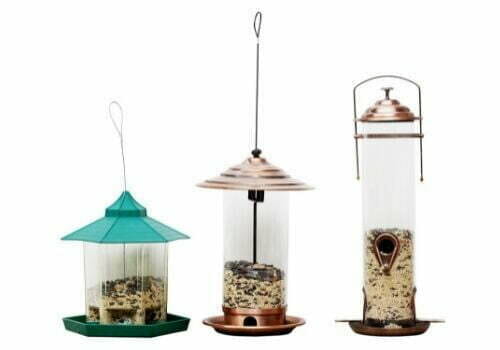
To keep rats away from your bird feeder, position it in places that discourage rats from accessing the food. Rats are agile climbers and can easily scale walls, fences, or trees to reach bird feeders. To keep rats away from bird feeders, position them in an open area away from any structures or trees they could use to climb up.
Keep a safe distance between the feeder and potential climbing points to discourage rats from reaching the food source. Allow enough space to prevent them from jumping from nearby objects.
When placing a bird feeder, keep rats in mind. They can jump up to 4 feet horizontally and 3 feet vertically. Make sure there is at least a 10-foot gap between the feeder and any structures that rats could use to reach it. This reduces their chances of success and encourages them to seek easier food sources.
Inspect the area around your bird feeder for overhanging branches that rats could use as a bridge. Trim or remove them to create a barrier and discourage the rodents from attempting to access the feeder. Rats will always choose the easiest food route, making it more difficult for them.
Installing Rodent-proof Bird Feeders
Stop rats from stealing your bird seeds with a rodent-proof bird feeder. These feeders are designed to outsmart even the craftiest of rodents. Only birds can enjoy the feast, while rats are left frustrated.
Features to Look in Rodent-proof Feeders and how they work
- Squirrel Baffle: Use a squirrel baffle to keep rodents away from your feeder. Choose a sturdy, well-designed baffle to prevent squirrels and other critters from accessing the feeder. The squirrel baffle is a barrier that prevents squirrels or rats from accessing the feeder by creating a cone-shaped obstruction between the ground and the food source, making it impossible for them to climb up and reach the food.
- Proof Construction: Choose sturdy metal or strong plastic feeders to withstand rat chewing. Look for ones with reinforced openings, secure lids, and strong joints to keep rodents out.
- Weight-Activated Mechanism: Choose bird feeders with weight-activated mechanisms that block access to larger animals like rats, ensuring they can’t get to the food. The weight-activated mechanism is a game-changer. As soon as rodents try to land on the feeder, their weight triggers the mechanism, causing it to close off access instantly. It’s like having an invisible bouncer guarding the entrance, allowing only birds to feed.
- Seed Flow Control: Consider seed flow control in rodent-proof feeders. Adjustable perches or feeding ports accommodate different bird sizes while deterring larger pests like rats. Attract a variety of birds without compromising security.
Rodent-proof feeders have adjustable perches/feeding ports to prevent larger animals from stealing bird seeds. It ensures that only birds of suitable size can enjoy their meal.
Avoiding Open Platform Bird Feeders
Open platform bird feeders can attract rats, contaminating the bird food and returning for more. Alternative feeder designs can deter rodents and protect your feathered friends.
Consider using closed or caged feeders instead of open-platform ones to keep rats out of your bird feeder. These designs provide a physical barrier preventing rats from accessing the food while allowing birds to enjoy their undisturbed meals.
Closed tube feeders are an excellent choice as they have small openings that only allow birds to access the seed inside. The narrow design makes it nearly impossible for rats to squeeze through and steal the food. Some closed tube feeders come with weight-activated perches that close off access when heavier animals like squirrels or rats land on them.
Caged feeders offer another effective solution by surrounding the feeding area with wire mesh or bars. Birds can enter through gaps in the mesh, but rats will find it incredibly challenging to squeeze through. These feeders often have a small entrance that only birds can navigate.
Gardman Feeding Station: A Rat-Resistant Option
The genius behind Gardman feeding stations lies in their design, which incorporates several features specifically aimed at deterring rats. Let’s take a closer look at these rat-resistant elements:
- Weather Guards: The feeding station comes equipped with weather guards that prevent rats from accessing the bird food. These guards are strategically placed to create barriers that only birds can navigate, thanks to their smaller size and nimble nature.
- Easy Access for Birds: While keeping rats out, Gardman feeding stations ensure easy access for our feathered friends. The design includes perches and feeding ports that accommodate various bird species, allowing them to enjoy their meals without interference from unwanted guests comfortably.
- Secure Fastenings: Another feature worth mentioning is the secure fastenings on the feeding station. Rats are notorious for their ability to squeeze through small spaces or use their dexterity to open latches and lids. However, with Gardman’s sturdy fastenings, these clever critters will find it nearly impossible to gain access.
Protecting Feeders from Above and Below
Installing baffles or squirrel guards above feeders
One effective strategy is to install baffles or squirrel guards above the feeders. These clever contraptions act as a physical barrier that rats cannot overcome. Baffles are typically dome-shaped devices made of metal or plastic that can be attached to the top of a feeder pole or hung from an overhead structure. Their curved shape prevents rats from gaining a foothold and climbing down toward the food source. Positioning baffles strategically creates an insurmountable obstacle for these pesky rodents.
Squirrel guards keep squirrels and rats away from bird feeders. They’re metal cages that allow birds easy access while preventing bigger animals from getting in. Installing them ensures that only birds get to enjoy the feast.
Predator Guard Squirrel Baffle
Keep your hanging bird feeders and poles safe from rats, raccoons and squirrels with this anti-rust galvanized steel protector.
Using pole guards or cones
To keep rats away from bird feeders, use pole guards or cones to prevent them from climbing up the poles. These cylindrical devices create barriers that make it difficult for rats to grip and climb the smooth surface, protecting the feeder from unwanted visitors.
Use cones or inverted funnels at the bottom of the pole to keep rats away from bird feeders. These devices make it difficult for rats to climb up and reach the feeders, ensuring birds can enjoy their meals without disturbance.
Place Bird Feeder Away from House or Shelter
To keep rats away from your bird feeder, avoid placing it too close to your house or any other structure. Clear away any potential rat shelters, and create distance between the feeder and any hiding spots. Position it in a sunny area with good visibility and regularly inspect for new possible shelters or entry points. Stay vigilant and take preventive measures to enjoy the presence of feathered friends in your garden.
Do Not Use a PVC Pipe or Wood as a Bird Feeder Pole
Choosing the right type of pole is crucial if you want to keep rats out of your bird feeder. While PVC pipes and wood may seem like convenient options at first glance, they are not suitable for bird feeder poles.
Even though PVC pipes may seem strong, prolonged exposure to sunlight and temperature changes can make them brittle. This can make it easy for rats to chew through them, making PVC pipes useless for keeping rats away from bird feeders. Similarly, wooden poles are also vulnerable to rodent attacks, as rats can easily gnaw through them with their sharp teeth, rendering them ineffective.
When selecting a material for your bird feeder pole, opt for options that rodents find challenging to chew through or climb. Here are some alternatives that can help deter rats:
- Baffled Pole: Use a baffled pole system to prevent rats from climbing and accessing the food source. The cone-shaped guard below the feeder effectively provides a barrier against rats.
- Plastic: Plastic poles offer durability and resistance against rodent attacks. Look for sturdy plastic poles specifically designed for bird feeders. They provide an excellent alternative to PVC pipes while ensuring stability and longevity.
- Metal: Metal poles are another reliable choice. Opt for stainless steel or galvanized metal poles, as they are more resistant to chewing and corrosion.
HaaWinPl Bird Feeder Baffle Guard
The surface is smooth and long enough to make it impossible for the rats to climb.
Make sure the pole can hold the weight of your bird feeder. Secure it into the ground or use a mounting system. Check regularly for any damage and replace parts as needed. Remember, keeping rats out of your bird feeder requires choosing the right materials and implementing preventive measures.
Use Peppermint

An effective way to keep rats away from your bird feeder is by using peppermint. The strong scent of peppermint oil or plants is detested by rats. You can soak cotton balls in the oil and position them close to the feeder or plant peppermint around your yard. This will emit a scent that rats will find unpleasant and deter them from approaching.
Use Spicy Food to Stop Mice and Rats
If you’re tired of those pesky mice and rats invading your bird feeder, it’s time to bring out the big guns – spicy food! Spicy birdseed can deter mice and rats from invading your bird feeder. Certain spices repel rodents and make them think twice before eating.
Cole’s HM20 Hot Meats Bird Seed
A mixture of food grade chili concentrate and sunflower meats effectively deters chipmunks and also attracts more birds.
Add cayenne pepper or hot pepper seeds to birdseed to deter rodents. While birds don’t have the taste receptors that make capsaicin spicy for us humans, rodents are highly sensitive to it.
Types of spices that can be effective
Cayenne pepper is a popular choice if you’re looking for a way to repel rodents. It’s strong scent and hot flavor can scare even the most fearless ones away. But if you’re feeling adventurous, you can use different spices for a change.
Black pepper is a spice that can be useful in keeping rodents away. It has a strong scent that they find unpleasant, similar to cayenne pepper. To prevent persistent critters from getting to your birdseed, try sprinkling some finely ground black pepper on it as an extra deterrent.
Another option is cinnamon. It adds a delightful aroma to your bird feeder area, and its scent also acts as a natural repellent for rodents. Mixing the cinnamon powder with your birdseed will keep the pests away and add a pleasant touch of fragrance.
Experimenting with different spice
Like humans, rodents have unique preferences. Cayenne pepper may deter some, while others may need a blend of spices to stay away. Trying different spice combinations can aid in identifying the ideal repellent for your bird feeder.
You may want to consider mixing cayenne pepper, black pepper, and cinnamon to create a powerful blend that effectively deters mice and rats. The combination of the strong scent of cayenne pepper, the pungent flavor of black pepper, and the pleasant aroma of cinnamon create an uninviting environment for these pests.
Another option is to mix various spices in equal amounts to make a repellent for rodents. This blend can consist of cayenne, hot pepper seeds, black pepper, and pungent spices such as cloves or garlic powder. Providing this spicy meal to the rodents will communicate a clear message: “Keep away from my bird feeder!”
Install Motion-activated Lights and Ultrasonic Devices
Abilly Solar Ultrasonic Rat Repellent Defender
An effective tool to keep rats away using solar power and ultrasonic technology.
Did you know that rats are nocturnal animals and don’t like bright lights? Installing motion-activated lights near your bird feeder can startle them and make them think twice before approaching. Another option is to use ultrasonic devices that emit high-frequency sounds that are unpleasant to rats but inaudible to humans. This is an effective way to repel rats without using any harmful chemicals.
Live Mousetraps and GLUE TRAPS
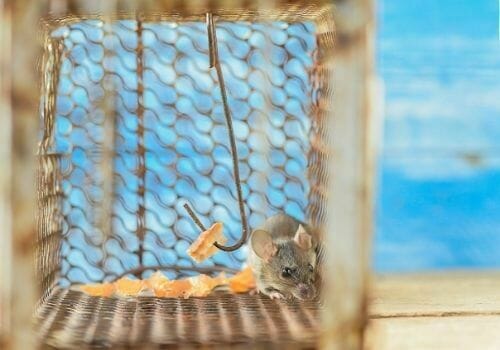
Live mousetraps catch rodents without harm by using bait to trigger a mechanism that closes the door behind the rat. This effective method ensures no harm to the rats while preventing mess or unpleasant sights associated with other rat control methods.
Consider using glue traps to keep rats away from your bird feeder. They are easy to use and readily available in stores. They require no setup or baiting; you only need to place them where rats will likely pass by. However, be aware of their potential cruelty towards non-target animals.
To use glue traps safely and effectively, place them in rat traffic areas, secure them with tape, and keep them out of reach of pets and children. Check the traps regularly and release rats humanely. Dispose of used traps in a sealed plastic bag in an outdoor trash bin to prevent other animals from getting trapped. This creates a safer environment for wildlife.
Trapping and Relocating Rats
Use humane traps to catch and relocate rats from your bird feeder. You can use humane traps if you want to get rid of rats without hurting them. These traps are made of a wire cage with a door that shuts once the rat enters. Put the trap near the bird feeder or where you have seen rat activity to increase the chances of catching them. Make sure you choose a trap for rats, as smaller ones designed for mice may not work well.
To effectively set up a rat trap, ensure it is stable and cannot easily be knocked over if the rat tries to escape. Lure the rat into the trap using tempting bait such as peanut butter or small pieces of fruit. When you successfully capture a rat, handle the trap carefully to prevent harm or stress to you and the rat.
Tips for Successful Trapping
Now that you have successfully trapped a rat, it’s time to safely relocate it away from your yard. Here are some tips to ensure successful trapping and safe relocation:
- Choose an appropriate relocation site: When releasing rats, choose an area at least one mile from your home to avoid causing problems for others. It’s best to avoid releasing them near residential areas or places where they could cause damage.
- Release during daylight hours: Rats are nocturnal creatures, so releasing them in the daytime reduces their chances of returning to your yard immediately.
- Provide food and water sources: If possible, release the rat near suitable food and water sources in its new environment to increase its chances of survival.
- Take precautions: When handling the trap, wear gloves to prevent potential diseases or parasites from spreading. Ensure your safety and avoid direct contact with the rat.
To control rodents, don’t just trap and relocate them. Address the underlying reasons they’re attracted to your yard.
Attract Owls in your Garden

If you’re looking for a natural way to keep rodents under control, consider attracting owls to your backyard. These nocturnal hunters won’t eat bird seeds so they won’t interfere with wild bird populations during the day. Inviting these natural pest controllers into your garden is an excellent way to manage the population of mice and rats. Avoid lighting your garden for a few weeks to attract owls, as they prefer natural lighting.
Avoid Making Rat-Friendly Garden

Rats are able to borrow, but they’re much better at tunneling through the ground cover. If you want to keep rats away from a bird feeder, eliminate the mulch or leaf litter that encourages them to make their safe house.
Many garden plants are very attractive to rats and other rodents because they provide a safe haven, abundant food source, or both. Generally, it is always best to avoid planting petunias (especially if you live in an area where rats are common), ivy, and fennel (this plant can be their favorite food).
Seeking Professional Help
While trapping and relocating rats can effectively solve minor infestations, knowing when to call in the professionals is essential. If you are facing a serious rat infestation that seems too much to handle or continues despite your attempts, it is strongly advised to seek professional assistance.
Pest control pros have the tools and expertise to get rid of rodents for good. They can also advise on how to prevent future infestations by finding and fixing entry points. Choose a reliable pest control service with good reviews and certifications in rodent control. Ask friends or neighbors for recommendations.
Conclusion
Keeping our bird feeders rat-free is essential to protect the safety and health of our feathered companions. To achieve this, we can follow various steps, including learning about rat behaviors, maintaining a tidy feeding area, using covered bins and feeders for seed storage, selecting appropriate feeders and seed, placing feeders strategically, installing rodent-proof bird feeders, trapping and relocating rats if needed, and using natural repellents like peppermint. Combine these strategies to keep rats away from bird feeders and ensure the safety of birds and their food.
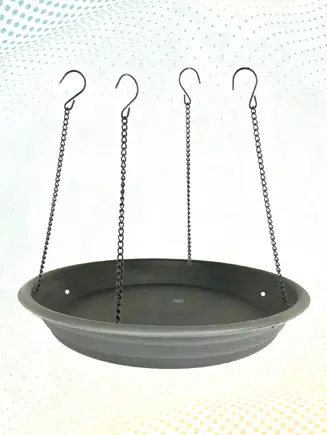
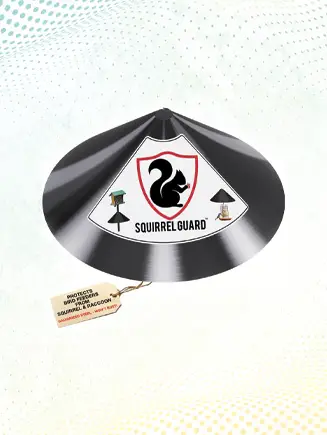
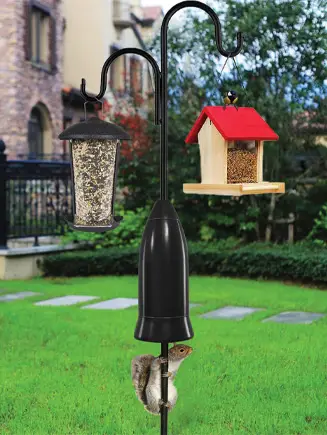

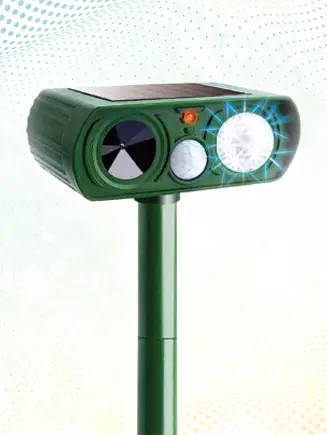
Please don’t promote the use of rat poison. You have mentioned owls here, and these and other birds of prey have had their numbers decimated by consuming poisoned rodents. Snap traps or electric traps – some which can effectively kill 60 to 80 rats before the batteries even need to be changed – are inexpensive. Poisoned rodents die slowly, making them easy prey for hawks, owls, dogs, and cats.
Agree. It is irresponsible to promote the use of ANY poison that an animal can ingest and suffer an agonizing death, in addition to poisoning and destroying the ecological food chain. There are many humane traps to use and release the rodents elsewhere.
I love my resident squirrel family. But I have a Japanese Garden with moss and the rats love the moss to burrow under. I can’t find a way to get rid of them and keep my squirrels. What we really need is a rat food with birth control. I wouldn’t mind a couple. But they are so prolific!!